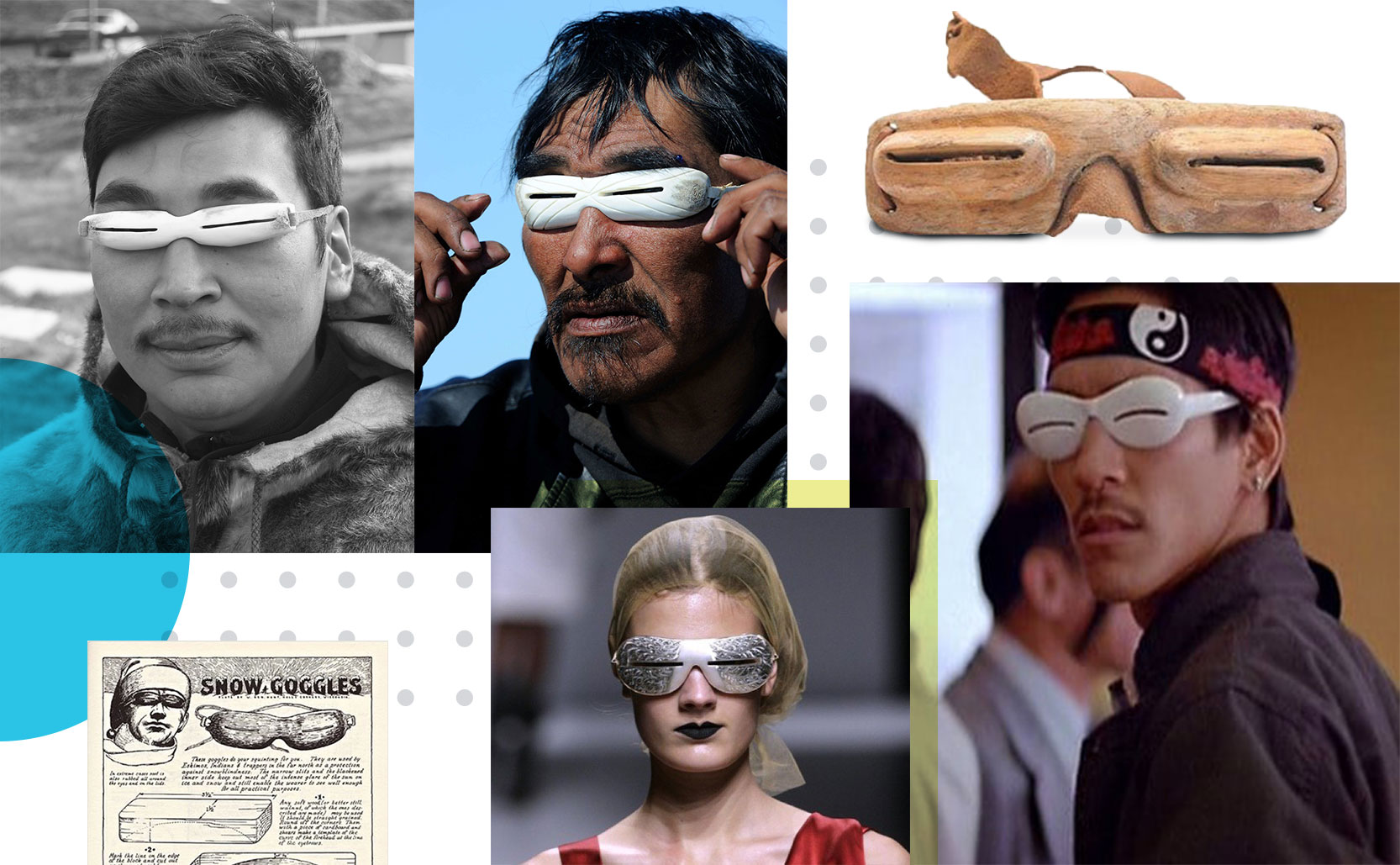Sunglasses
Humans have been making devices to shield their eyes from the sun for thousands of years. Today one company dominates the market.
Living around the Arctic where the bright sunlight reflects off the ice & snow, the indigenous peoples of North America & Greenland developed the earliest sunglasses. These 4,000 year old proto-sunglasses were carved from a variety of materials (ivory, antler, wood, etc.) and featured very thin slits allowing the wearer to see while keeping their eyes protected by blocking excessive sunlight. This idea has been recreated many times in a variety of styles from the 1930s to the present.

The Venetians, who had been making clear corrective eyeglasses since the 13th century, were among the first to produce sunglasses with glass. In the 18th century the glass makers of Murano produced green-tinted eyeglasses (as well as what resemble handheld mirrors but with transparent green glass) through which wealthy Venetians could look across the water while protecting their eyes from reflected light. Green glasses were also thought to help with eye strain caused by long hours of reading.

By the 19th century it was not uncommon for soldiers, on both sides of the American Civil War, to wear colored spectacles of blue/gray/green to protect their eyes while marching in the sun. But sunglasses were still primarily utilitarian. They didn’t become a fashionable part of mainstream culture until the 20th century.
20th Century Sunglasses
In the early 20th century Sam Foster had a plastics company that primarily sold women’s hair accessories, but as the trend in women’s hair changed to shorter hair styles (negating the need for so many hair accessories), he had to find a new product to sell. In 1929 he began selling inexpensive plastic sunglasses to beachgoers for 10 cents a pair on the Atlantic City boardwalk. This was the beginning of the Foster Grant eyewear company. Foster Grant sunglasses became the shades of Hollywood celebrities which helped make sunglasses not just about protecting your eyes but also about fashion. Sunglasses could now be about style as well as function.
In 1929 Bausch & Lomb, who were already making optical equipment for the military, began work for the U.S. Army Air Corps developing sunglasses that wouldn’t fog up and would reduce glare for pilots. This gave us the iconic “Ray-Ban Aviator” sunglasses. Aviator sunglasses were also the start of Ray-Ban eyewear company, which began as the civilian division of Bausch & Lomb. Ray-Ban would go on to make another iconic model of sunglasses, the Wayfarer, in 1956.
(Side fact: Roy Orbison fell into his wayfarer signature style accidentally while on tour with the Beatles in 1963. He forgot his regular glasses on the plane and had to wear his wayfarer sunglasses on stage, and thus was born his iconic look.)

Luxottica
Today the sunglasses market is dominated by Luxottica, an Italian eyewear juggernaut which is the largest eyewear company in the world. They’re the company actually making the sunglasses of luxury brands such as Chanel, Prada, Ralph Lauren, Versace, etc. Luxottica’s dominance is due in large part to their vertical integration control over the eyewear industry. They own major distribution retail stores such as LensCrafters, Target Optical, Pearle Vision, and Sunglass Hut. They own major eyeglass brands including Oakley and Ray-Ban, and they manufacture the eyewear for all of the above. They even own EyeMed, the second largest vision insurance company in America. You could go from getting a vision prescription, to selecting a pair of glasses, to buying them at a retail store and pay Luxottica at every step of the way.
Luxottica’s control over the market is why eyewear prices have gone up and not down. The proliferation of brands & stores competing for sales isn’t as competitive as it seems since Luxottica is behind many of them. In Luxottica owned stores 89% of the products available are made by Luxottica. Most of these glasses are the same quality, just different styles. Because of Luxottica, frames that cost maybe $15 to produce can be sold for hundreds of dollars. As of 2019 Luxottica controlled around 40% of the eyewear market.
Added info: Beyond just blocking excessive bright light, good sunglasses block most ultraviolet (UV) light from damaging your eyes. Darker glasses don’t necessarily block more UV light so it’s worth buying reputable sunglasses that have been engineered & certified to offer UV protection. It’s better to not wear any sunglasses at all than ones that don’t block UV light because your pupils will widen in the shade of junk sunglasses and in so doing allow in more UV rays.


